
Alexander Heinle
Alex is a marketer at Zavvy. On this blog, he mainly shares insights gained from discussions with selected experts and from helping our customers set up and improve their onboarding or learning programs.

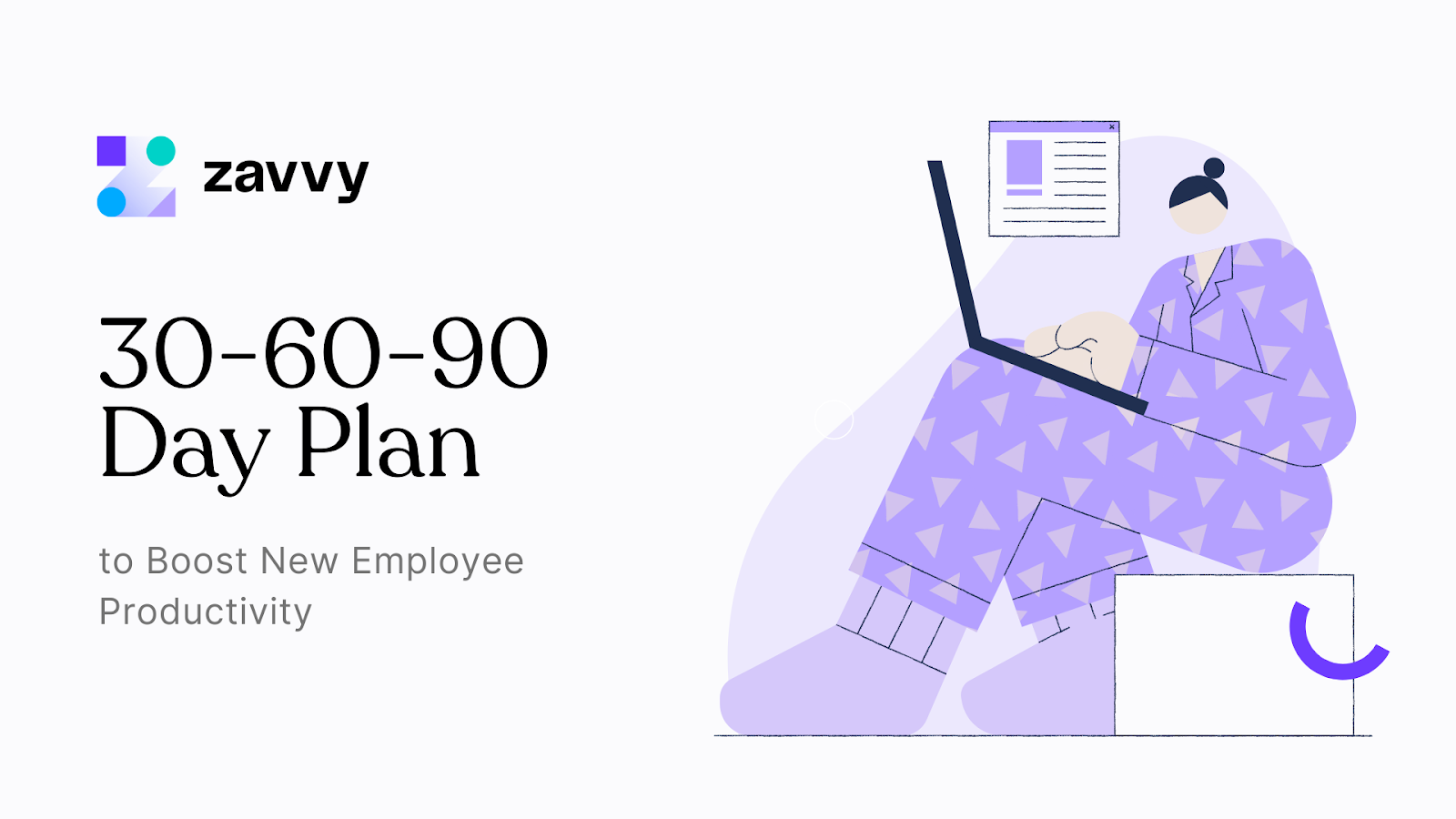
Starting a new job is equal parts exciting and intimidating. There's so much to learn and absorb, so many people to meet, a brand-new culture to adapt to and adjust to one's own expectations. No wonder new hires can take up to 8 months to fully onboard.
A 30-60-90 day plan lets you set realistic expectations and clear milestones to help your new employees quickly ramp up and deliver value. It serves as a new hire's universal onboarding guide. And it allows them to easily acclimate themselves to the new rules and culture from day one.
In this guide, we'll outline the main components of an effective 30-60-90 day plan, share valuable tips, and a template to help you create a solid plan for your employees and ensure a successful onboarding process.
Together with our curators, we have created a library of actionable digital marketing resources. Personalized to your team's needs.
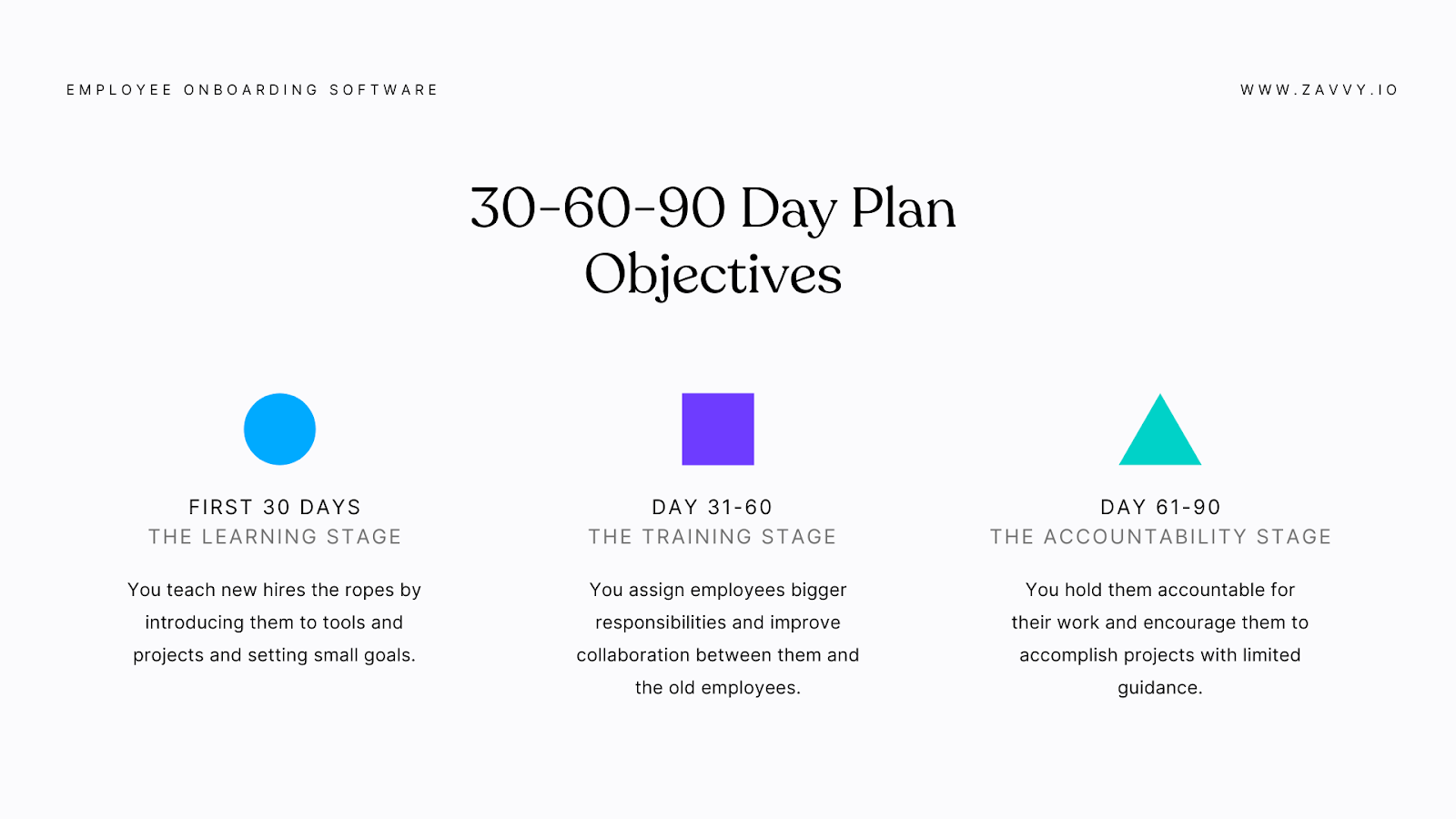
A 30-60-90 day plan acts as a formal action plan for your new employee's first 30, 60, and 90 days on the job. It helps managers and leaders set specific, manageable goals tied to the company's core values and mission and align with the role's duties and expectations.
The result? Maximized workout within the first three months of starting work.
While the level of detail of a 30-60-90 day plan varies based on the role and individual, all plans have a similar structure and end motive. Here's what a 30-60-90 day plan generally tries to achieve:
The purpose of a 30-60-90 day plan is to help new hires understand their expected milestones and deliverables for their first 90 days at work and make them feel welcomed into the company.
A good 30-60-90 plan should:
Keeping these factors in mind, your company can experience the following benefits:
In a nutshell, implementing a 30-60-90 day plan creates a clear focus for a new employee's first 90 days on the job and integrates them quickly and smoothly into the organization. It also encourages self-management and goal accomplishment, facilitating employee motivation and helping them gain more confidence.
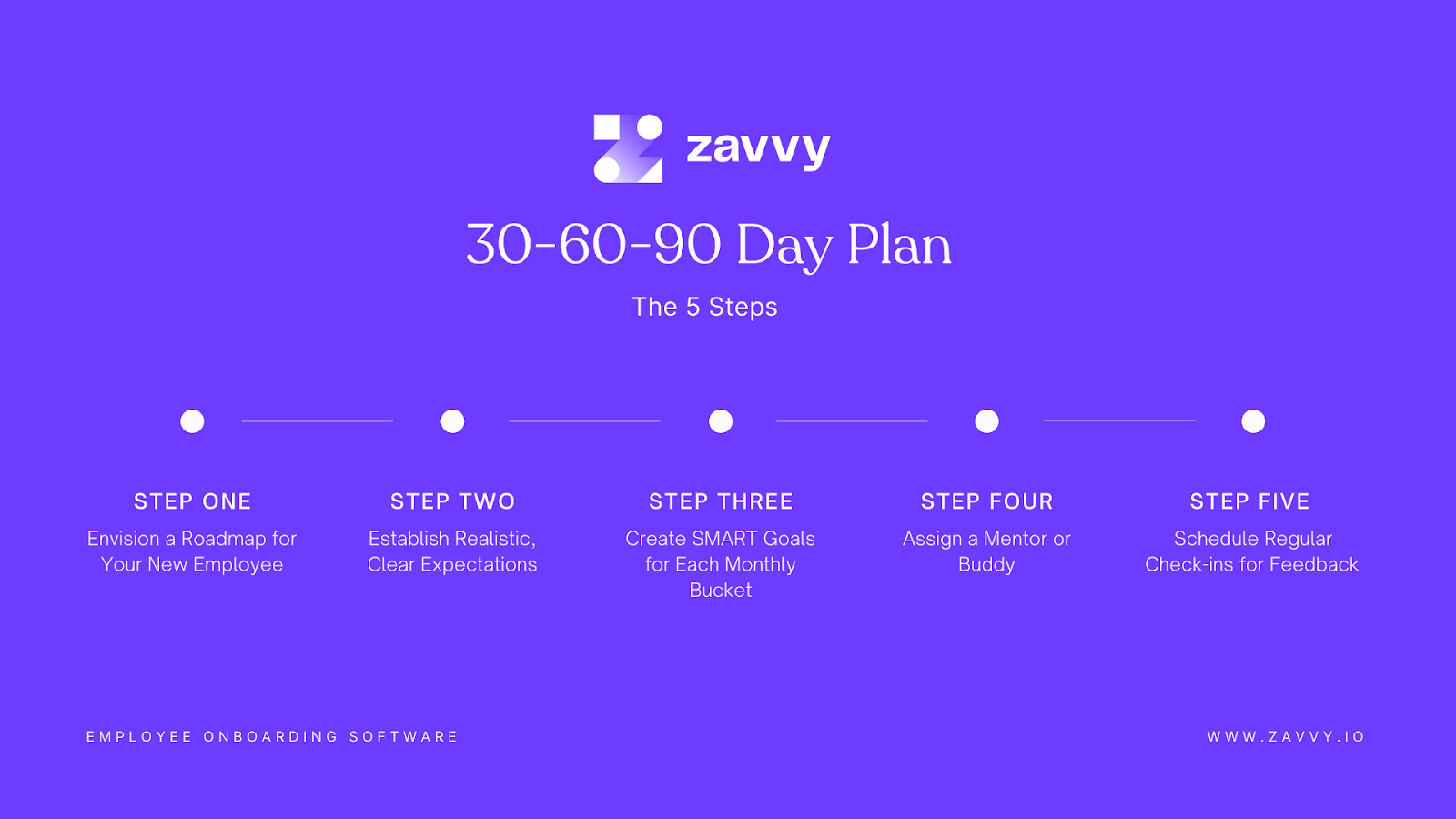
Typically, you'll write a 30-60-90 day plan before a new hire comes on board—or immediately after they begin their job. You won't know a lot about your new employees' personalities or strengths, which is why you should use your (realistic) expectations of what you want them to do or be like after 90 days as guiding factors.
Keeping this in mind, here are five steps to writing an effective 30-60-90 day plan.
Before starting your 30-60-90 day plan, you need a clearer understanding of how your new employees fit in your company's big picture. And what better way to assess this than asking questions?
Ask yourself questions about the job role, the onboarding process, and the team, like:
Your 30-60-90 day plan should give new employees a clear idea of what the first three months will look like. Then, when you have a clear roadmap set up, you can create a better plan that sets them up for success and helps build the necessary skills for the job.
Be realistic when creating a plan for new employees. Understand there's only so much they can learn and do within their first few months of starting work. After that, you can have them address urgent needs, but don't throw too much on their plate too fast.
How do you ensure you don't end up overwhelming your new employees? Think about what a reasonable workload should look like and minimize it for the first 30 days. Account for the learning curve when employees start carrying out their responsibilities, so you'll have to adjust their workload accordingly.
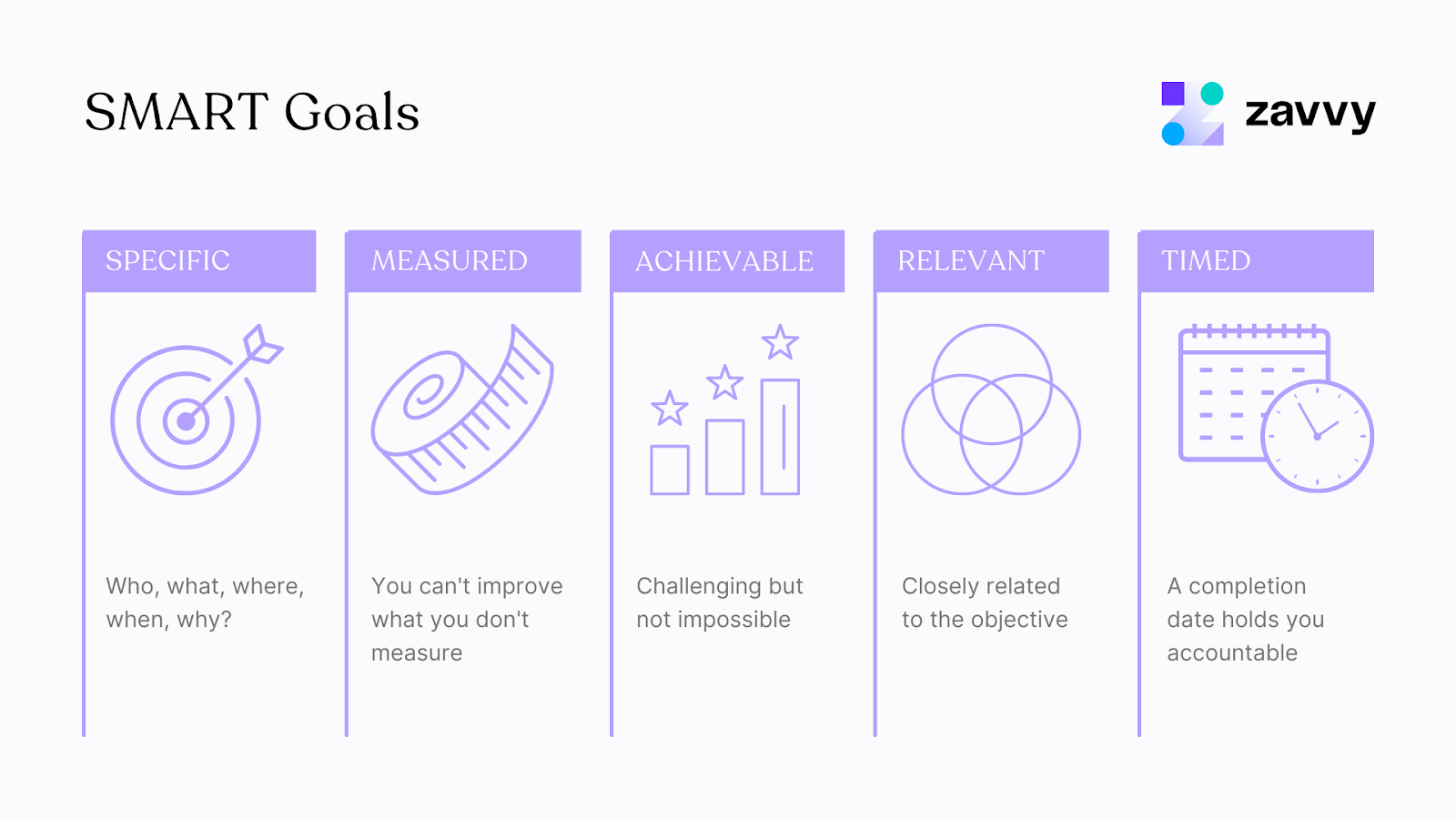
Giving new employees SMART goals when they join your company can increase retention. How? It gives them a measurable goal to work toward, keeping them engaged. Having plans to fulfill ensures new hires don't feel their only job is to shadow other team members.
The SMART goals used for new employees will vary depending on their role and level within the company. For example, your goal for a customer support representative can be to close 20 tickets, including learning the internal computer system and understanding how to tackle technical issues.
Similarly, you can aim for a new in-house writer to successfully publish five articles, including taking two of them through the entire publishing process—from writing to making internal edits to implementing client feedback—all by themselves.
Guidance and feedback are critical aspects of a 30-60-90 day plan.
You can't simply hand over a document to your new employee and expect them to complete the assigned tasks. No, you'll have to guide them as they collaborate with you and other team members to accomplish set duties and responsibilities—the document is supposed to serve as a reference only.
When writing your plan, assign a buddy or mentor to your new employee. This person will guide them during the first few weeks and help them adjust to the new work environment. Ensure the buddy understands their responsibility towards the new hire and always maintains a friendly approach towards the new employees.
There's no guarantee the first 90 days will go as you outlined in your plan. For example, your new hire may take more time to get accustomed to the new work environment. Or, another team may need the employee to help them for a week.
In either case, this will derail the SMART goals you initially set for them. Your 30-60-90 day plan is just an outline and not a schedule. Some employees will easily meet responsibilities; some won't. Adjust for each situation accordingly.
As the name suggests, you want to think of your 30-60-90 day plan in monthly chunks. Each phase will have a specific focus, backed by your top priorities, supporting concrete goals and metrics to measure success.
Below is a comprehensive 30-60-90 day template that Zavvy uses to ensure a successful onboarding for our clients. We've broken down the plan into monthly buckets, complete with general directions for each to guide you towards success.
You should have a specific focus for each month that makes new employees familiar with how things work in your company and helps them understand how to contribute towards its growth.
The first month should be all about learning, the second about planning and encouraging development, and the third about execution and making active suggestions and changes to the status quo. The idea is to create a seamless onboarding strategy that sets the tone for company expectations and serves your primary objectives.
Another significant advantage of a 30-60-90 day plan is that it acknowledges each monthly phase's learning curve and aims to smoothen the transition.
When creating a plan, detail your high-level priorities for each monthly bucket. You also want employees to achieve their individual goals through each phase. For example, new hires can learn internal processes, perform responsibilities independently, and propose solutions to a critical problem for each month respectively.
Setting crystal clear goals is an integral part of a successful 30-60-90 day plan. When setting goals, you want each one of them to ladder up to your intended focus and priorities. A good tip is to break them into simple categories, like:
How will you identify which goals have been achieved?
Using specific metrics, you can track the overall progress, celebrate successes and milestones, and identify opportunities for employees. For example, you can use quantifiable metrics (revenue, sales) or qualitative metrics (testimonials, reviews) to measure the results of goals.
Assess progress and give feedback to employees every 30 days. Also, hold back when making amendments to your plans.
Focus
Priorities
Goals
Focus
Priorities
Goals
Focus
Priorities
Goals
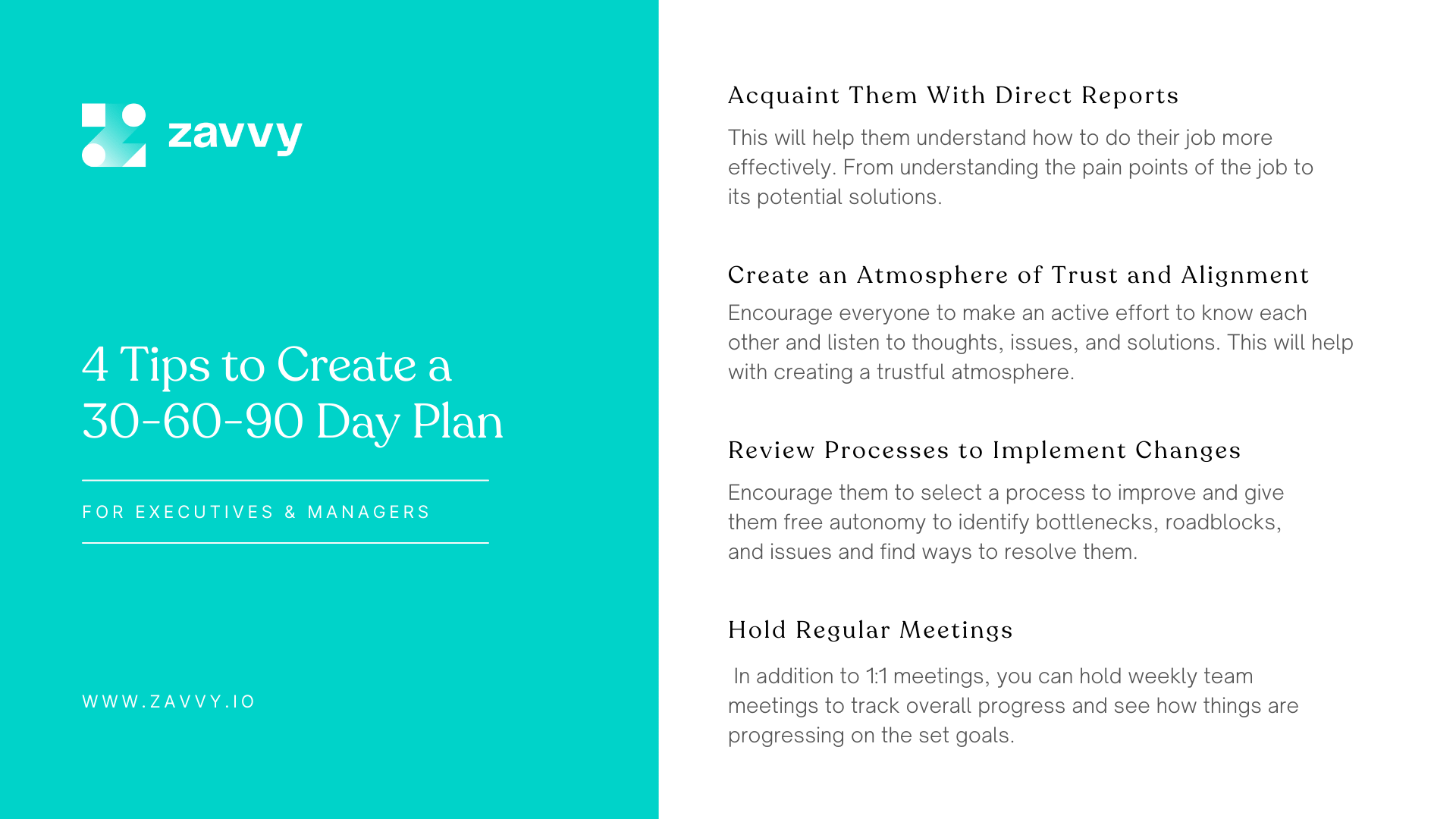
A 30-60-90 day plan for executives and managers will be different from that for junior employees. Here are a few tips for creating an effective plan for higher-level executives.
During the first 30 days, executives and managers should set aside a large portion of their schedule interviewing direct reports. This will help them understand how to do their job more effectively, including:
You want managers and executives to understand the company's strengths and weaknesses and identify areas for improvement. By listening to their direct reports, they'll gain a deep, functional knowledge of your new department and determine the current reality of the work environment.
When creating a 30-60-90 day plan, make sure the manager or executive spends ample time with the employees. Encourage everyone to actively know each other and listen to thoughts, issues, and solutions.
This will create an atmosphere of trust and alignment, ensuring both parties work with their best interests and the organization's in mind.
The executive or manager should make active suggestions during the second month to optimize existing departmental processes. They should also identify better ways of getting things done as they learn how things are done.
Encourage them to select a process to improve and give them free autonomy to identify bottlenecks, roadblocks, and issues and find ways to resolve them. If they want to implement a new process, trust them and let them test the new process. You can always review the process in the end based on results.
Make sure you regularly check in with your new managers and executives. In addition to 1:1 meetings, you can hold weekly team meetings to track overall progress and see how things are progressing on the goals set for the 60-day and 90-day portions of the plan.
Let's turn the tables and think from the employee's perspective.
How would you create a 30-60-90 day plan to impress a hiring professional and make you stand out from the competition? Here are a few tips.
You cannot create a solid 30-60-90 day plan without having a clear idea of what the prospective company is looking for.
Spend time researching the mission, core values, and any other information on the current processes and products of the company you're applying to. Be sure to cater your plan specifically to its culture, too.
Tell your 30-60-90 day plan to the position you are applying for instead of taking a shot in the dark. You may have ideas for the company as a whole, but you also want the plan to be role-specific to prove what a valuable asset you can be for the team. Consider the following:
You need to explain to the hiring manager how you fit into the company's bigger picture. The better you do this, the higher your chances of landing the job.
A crucial aspect here is first to understand your own priorities and then align them with their priorities. Next, think about why you'll be hired for the position and how you can use your skills to solve a specific problem within the team. Finally, think about the bigger picture of what your job should look like, and then move forward from there.
Additionally, all goals in your plan should have a means for you—and your manager—to measure the outcome. For instance, you can suggest qualitative data to support your goals (increased website views, revenue increases, positive customer reviews).
Prepare a copy of your 30-60-90-day plan a day before your interview. This can be in a PowerPoint presentation, a hard copy, or slides.
During the interview, explain your plan in great detail, including the goals you want to set, how they relate to the accomplishments you've had in the past, and ways you can help the company achieve its desired objectives.
Be sure to ask any questions you may have about your role and what's expected of you, and make suggestions on incorporating them into your current plan.
Now that we've discussed the value of an effective 30-60-90 day plan, along with a template, examples, and tips, you need to figure out your next steps to draft one for your company.
Remember, the first 30 days will require the most structure and minimized workload, while the 60-day and 90-day portions can be more department- and role-specific.
According to recent employee statistics, 60% of businesses don't set any goals or milestones for new hires. Zavvy can ensure your company isn't a part of this statistic. Our employee development software makes it easier to build goal-focused plans, complete with deadlines, to bridge the gap between theoretical plans and actual measures.
Use it to guide new employees through the process with engaging reminders, tasks, and reflections—all at the click of a button. Connect with our experts for a free demo anytime!
Upskill your team every week with the best contents and personalized recommendations.

Starting a new job is equal parts exciting and intimidating. There's so much to learn and absorb, so many people to meet, a brand-new culture to adapt to and adjust to one's own expectations. No wonder new hires can take up to 8 months to fully onboard.
A 30-60-90 day plan lets you set realistic expectations and clear milestones to help your new employees quickly ramp up and deliver value. It serves as a new hire's universal onboarding guide. And it allows them to easily acclimate themselves to the new rules and culture from day one.
In this guide, we'll outline the main components of an effective 30-60-90 day plan, share valuable tips, and a template to help you create a solid plan for your employees and ensure a successful onboarding process.
Get a demo!
We'll be happy to show you around and answer all your questions.
Trusted by innovative companies



We'll be happy to show you around, answer your questions, or arrange a free trial.
Erhalten Sie eine kostenlose Demo unserer Onboarding-Software.
Vertraut von



Your Training & Development Strategy - Solved in 1 Tool.
Trusted by innovative companies



We'll be happy to show you around, answer your questions, or arrange a free trial.
Learn how Zavvy helps you drive performance, development, and engagement.
Trusted by innovative companies



We'll be happy to show you around, answer your questions, or arrange a free trial.
We'll be happy to show you around and answer all your questions.
Trusted by innovative companies



We'll be happy to show you around, answer your questions, or arrange a free trial.
Gerne zeigen wir Ihnen ganz unverbindlich unsere Plattform im Detail.
Vertraut von modernen Unternehmen



Get a demo!
We'll be happy to show you around and answer all your questions.
Trusted by innovative companies



We'll be happy to show you around, answer your questions, or arrange a free trial.
Erhalten Sie eine kostenlose Demo unserer Software für Mitarbeiterenwicklung und Training.
Moderne Unternehmen
setzen auf Zavvy


